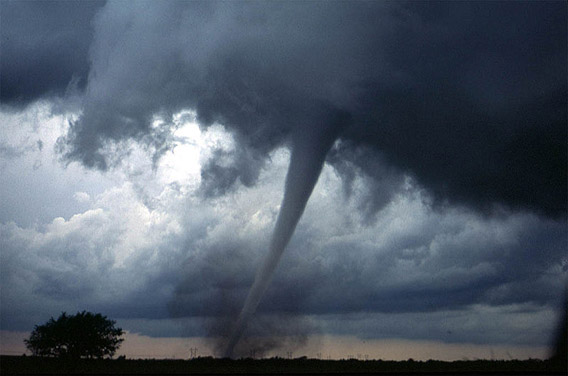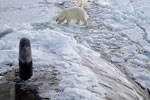
Image of a 2006 tornado in Oklahoma. Photo by: NOAA.
Last Friday, around a hundred tornadoes left a wake of destruction in the U.S., killing 39 people to date and destroying entire towns. The tragedy hit hardest in Kentucky and Indiana and experts predict the weather-disaster will cost over $1 billion. But isn’t this early for tornado season? Yes, say experts, and climatologists add that while research on tornadoes and climate change is currently in its infancy, it’s possible, probably even likely, that climate change is expanding tornado season in the U.S. due to the earlier arrival of spring.
“Friday’s tornado outbreak was fueled, in part, by high instability created by unusually warm, moist air flowing north from the Gulf of Mexico due to the high water temperatures there. This exceptionally warm air set record high temperatures at 28 airports in […] the afternoon of the tornado outbreak,” writes meteorologist Jeff Masters at his weather blog.
While climatologists caution that one should not attempt to prove climate change on the basis of single weather events—it’s the long-term trends that matter—data hints that tornadoes maybe arriving earlier. According to Masters’ blog the top five tornado outbreaks occurring abnormally early in year (i.e. January-early March) have all taken place in the past 16 years (this includes data going back to 1950). Three of the top five occurred in just the past five years. This may be due to better detection of tornadoes over the decades or it could be linked to climate change. Either way, a longer spring is likely to allow tornado conditions to arrive earlier.
“As spring moves up a week or two, tornado season will start in February instead of waiting for April,” noted climatologist Kevin Trenberth of the National Center for Atmospheric Research told Reuters.
This, however, does not mean that climate change is making tornadoes worse. Currently, little research has been done on if, or how, climate change impacts the frequency and intensity of tornadoes. The best scientists can say is that warmer average temperatures boosts the intensity of storms, creating fiercer weather patterns, however warmer temperatures have also been linked to dampening wind shear at high altitudes. The prognosis: climate change may make tornado outbreaks more intense, but occur less frequently even as tornado season expands. Still, it must be cautioned that scientists’ understanding of how tornadoes change in a warmer world will likely shift as more research is conducted.
Aside from tornadoes, scientists have gathered solid evidence that climate change is increasing both the intensity of floods and droughts.
Trenberth told Climate Progress last year that added water vapor (around 4 percent) in the atmosphere from climate change is propelling more extreme weather.
“[The extra water vapor] invigorates the storms, it provides plenty of moisture for these storms and it’s unfortunate that the public is not associating these with the fact that this is one manifestation of climate change. And the prospects are that these kinds of things will only get bigger and worse in the future.”
Global temperatures have risen 0.8 degrees Celsius (1.44 degrees Fahrenheit) since the Industrial Revolution. The past decade (2000-2009) was the warmest on record. Currently, nine of the ten hottest years globally have occurred since 2000 and there hasn’t been a single year below the 20th Century average since 1975. Governments have pledged to keep global temperatures from rising above 2 degrees Celsius (3.6 degrees Fahrenheit), however experts warn we are running out of time.
Related articles
Arctic warms to highest level yet as researchers fear tipping points

(02/13/2012) Last year the Arctic, which is warming faster than anywhere else on Earth due to global climate change, experienced its warmest twelve months yet. According to recent data by NASA, average Arctic temperatures in 2011 were 2.28 degrees Celsius (4.1 degrees Fahrenheit) above those recorded from 1951-1980. As the Arctic warms, imperiling its biodiversity and indigenous people, researchers are increasingly concerned that the region will hit climatic tipping points that could severely impact the rest of the world. A recent commentary in Nature Climate Change highlighted a number of tipping points that keep scientists awake at night.
Targeting methane, black carbon could buy world a little time on climate change

(01/12/2012) A new study in Science argues that reducing methane and black carbon emissions would bring global health, agriculture, and climate benefits. While such reductions would not replace the need to reduce CO2 emissions, they could have the result of lowering global temperature by 0.5 degrees Celsius (0.9 degree Fahrenheit) by mid-century, as well as having the added benefits of saving lives and boosting agricultural yields. In addition, the authors contend that dealing with black carbon and methane now would be inexpensive and politically feasible.
Seals, birds, and alpine plants suffer under climate change

(01/11/2012) The number of species identified by scientists as vulnerable to climate change continues to rise along with the Earth’s temperature. Recent studies have found that a warmer world is leading to premature deaths of harp seal pups (Pagophilus groenlandicus) in the Arctic, a decline of some duck species in Canada, shrinking alpine meadows in Europe, and indirect pressure on mountain songbirds and plants in the U.S. Scientists have long known that climate change will upend ecosystems worldwide, creating climate winners and losers, and likely leading to waves of extinction. While the impacts of climate change on polar bears and coral reefs have been well-documented, every year scientists add new species to the list of those already threatened by anthropogenic climate change.